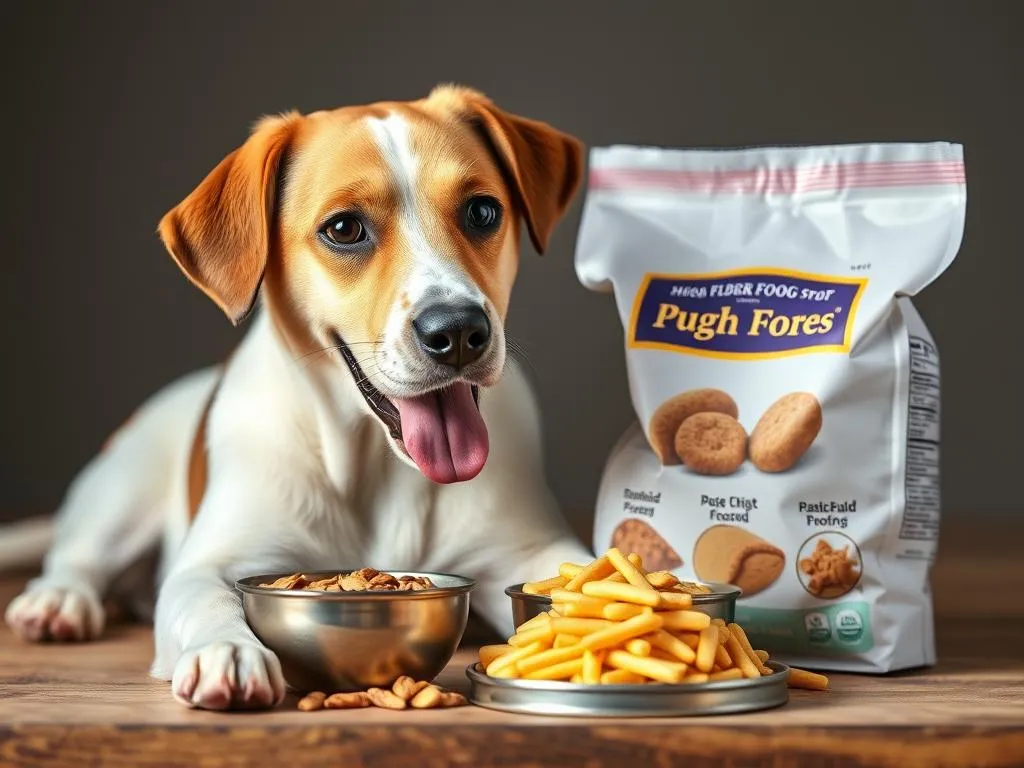
Introduction
Dog nutrition plays a crucial role in maintaining the overall health of our furry friends. One essential component of a balanced diet is fiber, which can significantly impact a dog’s digestive health. Fiber helps regulate bowel movements, and its importance cannot be overstated, especially when addressing common digestive issues like constipation. In this article, we will explore the best high fiber dog foods for constipation, offering insights into how fiber works, what signs indicate a need for more fiber in your dog’s diet, and the top products and recipes that can help alleviate this issue.
Understanding Dog Constipation
What is Dog Constipation?
Dog constipation is defined as infrequent or difficult bowel movements. It can lead to discomfort and pain for your pet. Symptoms of constipation include straining to defecate, producing hard and dry stools, and even showing signs of distress or discomfort when attempting to relieve themselves. Recognizing these symptoms early is vital for ensuring your dog’s well-being.
Causes of Constipation in Dogs
Several factors can contribute to constipation in dogs:
-
Dietary Factors: A low-fiber diet can lead to constipation. Insufficient water intake can also cause dehydration, which may harden the stool, making it difficult to pass.
-
Health Issues: Underlying medical conditions such as hypothyroidism, diabetes, or gastrointestinal disorders can contribute to constipation. Certain medications can also affect bowel movements.
-
Lifestyle Factors: Lack of exercise can lead to sluggishness in the digestive system, while stress can also disrupt normal bowel function.
The Role of Fiber in Dog Nutrition
What is Dietary Fiber?
Dietary fiber is a plant-based carbohydrate that is not digestible by dogs. It is typically categorized into two types: soluble fiber, which dissolves in water, and insoluble fiber, which does not. Soluble fiber can help to slow digestion and stabilize blood sugar levels, while insoluble fiber adds bulk to the stool, promoting regular bowel movements.
Benefits of Fiber for Dogs
Incorporating fiber into your dog’s diet offers several benefits:
-
Promotes Healthy Bowel Movements: Fiber helps to regulate bowel movements, preventing constipation and promoting overall digestive health.
-
Helps Regulate Blood Sugar Levels: Soluble fiber can help stabilize blood sugar levels, which is particularly beneficial for diabetic dogs.
-
Aids in Weight Management: High fiber foods can help dogs feel full with fewer calories, making it easier to manage their weight.
Signs Your Dog Needs More Fiber
Recognizing when your dog may need additional fiber is essential for their health:
-
Behavioral Signs: If your dog is straining to defecate, whining, or showing signs of discomfort, these may be signs that they need more fiber in their diet.
-
Physical Signs: Look for dry, hard stools or bloating, which can indicate constipation. If these signs persist, it may be time to consider a diet change.
-
Long-Term Health Implications: Untreated constipation can lead to serious health issues, including fecal impaction or colonic obstruction, making it vital to address dietary concerns promptly.
Choosing High Fiber Dog Foods
Key Ingredients to Look For
When searching for high fiber dog foods, consider the following key ingredients:
-
Sources of Fiber: Look for foods that include fruits, vegetables, and whole grains, as these are rich in dietary fiber.
-
Specific High Fiber Ingredients: Ingredients like pumpkin, sweet potatoes, and brown rice are excellent sources of fiber that can improve your dog’s digestive health.
Nutritional Requirements for Dogs
A balanced diet for dogs includes proteins, fats, carbohydrates, and fiber. It’s essential to consult with a veterinarian before making any significant changes to your dog’s diet, especially if they have existing health issues.
Top High Fiber Dog Foods for Constipation
Commercial Dog Foods
When looking for the best high fiber dog foods for constipation, consider these popular brands:
- Brand 1: Hill’s Science Diet Adult Sensitive Stomach & Skin
- Fiber Content: Approximately 4.5% fiber.
- Key Ingredients: Brown rice, barley, pumpkin.
- Pros: Formulated for sensitive stomachs, promotes digestive health.
-
Cons: May be more expensive than other brands.
-
Brand 2: Blue Buffalo Life Protection Formula
- Fiber Content: About 4% fiber.
- Key Ingredients: Whole grains, sweet potatoes, blueberries.
- Pros: Includes real meat as the first ingredient, rich in antioxidants.
-
Cons: Some dogs may have allergies to certain ingredients.
-
Brand 3: Nutro Ultra Grain-Free Dry Dog Food
- Fiber Content: Approximately 4.5% fiber.
- Key Ingredients: Lentils, chickpeas, and pumpkin.
- Pros: Grain-free options with high-quality protein sources.
- Cons: Some dogs may not prefer the taste.
Homemade High Fiber Dog Food Recipes
Making homemade dog food can be rewarding and allows you to control the ingredients. Here are a few high-fiber recipes:
- Recipe 1: High Fiber Pumpkin Dog Treats
- Ingredients: 1 cup canned pumpkin, 2 cups whole wheat flour, 1 egg, 1 teaspoon cinnamon.
-
Preparation Steps: Mix all ingredients until a dough forms. Roll out and cut into shapes. Bake at 350°F for 20-25 minutes.
-
Recipe 2: Sweet Potato and Green Bean Dog Food
- Ingredients: 1 cup cooked sweet potatoes, 1 cup cooked green beans, 1 cup cooked chicken (shredded).
-
Preparation Steps: Mash the sweet potatoes and mix with green beans and chicken. Serve as a complete meal.
-
Recipe 3: Brown Rice and Veggie Mix
- Ingredients: 1 cup cooked brown rice, 1 cup chopped carrots, 1 cup peas, 1 cup cooked turkey (shredded).
- Preparation Steps: Combine all ingredients and serve as a nutritious meal.
Tips for Transitioning to High Fiber Dog Foods
Gradual Transition Process
When switching to a high fiber dog food, it’s crucial to do so gradually to prevent digestive upset. Start by mixing a small amount of the new food with your dog’s current food, gradually increasing the new food’s proportion over a week.
Monitoring Your Dog’s Health
Keep an eye on your dog’s bowel movements and overall health during the transition. Look for changes in stool consistency, frequency, and any signs of discomfort. If issues persist, consult your veterinarian for further advice.
Conclusion
Incorporating the right amount of fiber into your dog’s diet is essential for their digestive health. By understanding the benefits of fiber and recognizing the signs of constipation, you can make informed decisions about your pet’s nutrition. Always consult with a veterinarian to ensure that your dog receives a balanced diet tailored to their unique needs. Maintaining a high-fiber diet can help prevent constipation and promote overall canine health.
FAQs About Dog Nutrition and Constipation
-
What are the signs that my dog needs more fiber?
Behavioral signs include straining to defecate and physical signs like hard stools. If these persist, consider increasing fiber in their diet. -
Can I switch my dog’s food suddenly?
It’s best to transition gradually to avoid digestive issues. Mix the new food with the old food over several days. -
Are there any side effects of a high-fiber diet?
Too much fiber can lead to gas and bloating. Monitor your dog’s reaction and consult your vet if necessary. -
How much fiber does my dog need?
The amount of fiber needed varies depending on the dog’s size, age, and health. A veterinarian can provide personalized advice.









